
Auckland Town Hall, 1980s. Photographer Eric Young, Auckland Libraries Heritage Collections 1021-0522
The Auckland Town Hall has hosted music events for over a century, with sounds onstage spanning from jazz to hip hop to dance music – and almost any other genre you might imagine. Some of the biggest names in music have performed in its Great Hall, including era-defining acts such as The Beatles, The Who, and The Foo Fighters. Many local acts have also risen to the level where they can headline. Recent examples include The Beths, Marlon Williams, and Unknown Mortal Orchestra.

Auckland Town Hall in 1924. – Photographer Henry Winkelmann, Auckland Libraries Heritage Collections 1-W0410
Music rang out from the Auckland Town Hall from the very start. It opened on Thursday 14 December 1911 with an organ recital that began with Bach’s ‘Toccata and Fugue in D Minor’. A few days later the Auckland Choral Society undertook Handel’s ‘Messiah’ backed by an orchestra and with three soloists from Australia.
The building was part of a larger civic complex which included the Mayor’s offices, so its design was austere compared to the flashy Civic or upmarket St James, which were constructed further down the street in the late 1920s. The upside of this was that the Town Hall could be put to a wide range of uses, including boxing matches and car shows.

The Auckland Town Hall Concert Chamber under construction in 1911. - Auckland-Libraries-NZG-19110628-0031-02
The Town Hall also features a second, smaller Concert Chamber built alongside the Great Hall. This room originally held choral performances, piano recitals, plays and musical theatre. Both rooms were built with excellent acoustics since they were built at a time when singers and performers couldn’t rely on PA systems to project their performance to the back of the crowd.
The Great Hall was originally built to seat 3000 people, though this number was far exceeded by a community singalong event in 1922, as the Auckland Star described at the time:
“By the time the singing started people were knee-deep in the aisles of the dress circle and crowding into the seats at the back of the platform … To hear that huge gathering singing with the accumulated lung-power of 4000 men and women, was nothing less than inspiring, while the happiness that radiated from the faces of the white-haired old men and women, lusty youth in their uniforms, venerable clergymen, professional workers in their working garb, business girls from the office, shop, and factory, certainly seemed for the space of an hour to verify all the claims made by the promoters of community singing.”

Bob Adam's Jazz Band at the Auckland Town Hall in 1920. - Auckland Libraries Heritage Collections 994-80
The music slowly changed with the times. In December 1920, a “super dansant” brought two very new styles of music to the Great Hall, through performances by Bob Adams’ Jazz Band (likely Aotearoa’s first) and Walter Smith’s Hawaiian Guitar Band. The chairs were removed so that the central floor area was left open for dancing. Between sets, the patrons sat at tables around the outer edge to have a light meal.
The Auckland Town Hall subsequently hosted two other events which propelled jazz forward in this country. In 1943, US clarinettist Artie Shaw brought his band to New Zealand to entertain the troops and his performance at the Town Hall educated many local musicians on what swing music was really all about. In 1950, a line-up of Auckland’s best jazz musicians demonstrated what they’d learnt in the years since with a performance in Concert Chamber. Mavis Rivers exhibited the vocal chops that would see her signed to Frank Sinatra’s label Reprise in the US a few years later.

Auckland's Premier Jazz Concert, Auckland Town Hall Concert Chamber, featuring Mavis Rivers, Crombie Murdoch, Dennis O'Brien, Dale Alderton, Colin Martin, Murray Tanner, George Campbell, Mark Kahi, Thomson Yandall and the Hugh Gordon Quartet. - Auckland War Memorial Museum, EPH-PT-15-1_001
However the Auckland Council were not so taken with this new upbeat form of jazz. In 1952, they banned jazz players from using the resident Steinway piano for fears that their agitated playing might damage it; they were instead relegated to the cheaper Chappell piano.

Merv Thomas - Auckland Town Hall, rock 'n' roll, c. 1957. - Merv Thomas collection
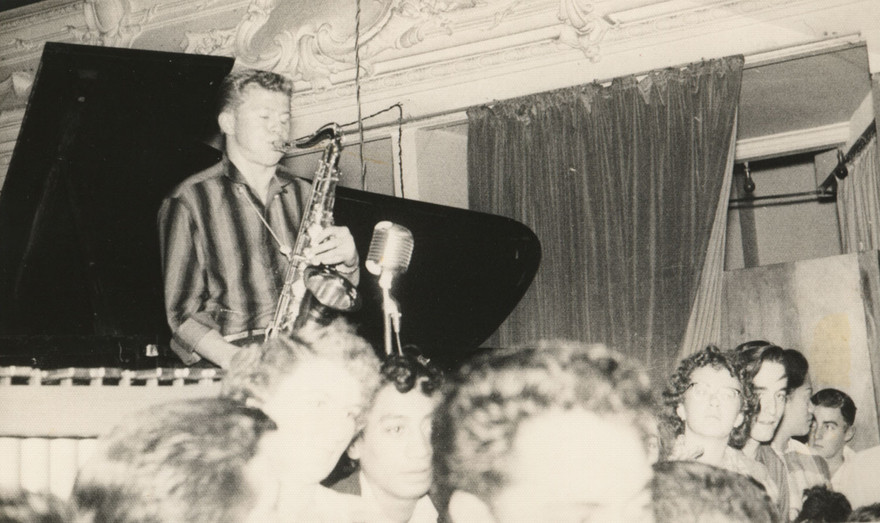
Bill Fairs at the famous rock'n'roll concert, Auckland Town Hall, 1959. - Bill Fairs collection
Rock’n’roll arrived at the Town Hall soon after it hit these shores, with Frank Gibson Sr leading his all-star group in front of a crowd of 750 people in 1957. This provided early proof of how popular the new genre would be. The irony was that the musicians were all jazzmen and theyhad hastily constructed their set by watching the latest rock’n’roll movies. In the dark of the picture theatre, singer Merv Thomas noted the lyrics, while saxophonist Bernie Allen jotted down the music.

Auckland Town Hall undergoing maintenance, c 1957. – Photo Harry Smith Collection, Auckland Libraries Heritage Collections 1730-080
Popular music, as performed by Māori and Pacific musicians, featured at several variety shows in the late 50s and early 60s. Jazz trumpeter Jim Warren was the New Zealand correspondent of the Australian Music Maker magazine, and was fulsome in his praise for the performers in an April 1959 “Māori Rock Show”.
Wearing a white tuxedo, the MC Ben Broughton opened the show by saying “Okay folks, this is where the natives take over ... You Pākeha think this rock’n’roll is something new. But we Polynesians have been doing it for years.” The acts included Ray Paparoa, Pukekohe’s Elvis impersonator, the junior Māori showband The Sunbeams (featuring a young Charlie Tumahai), big belter Rama White, Heke Kawene (“the Māori Fats Domino”), and Samoa’s slick Keil Isles. At the 1961 Festival of the South Seas, a huge event, the acts included Daphne Walker, Bill Sevesi and His Islanders, The Samoan Surfriders, and “graceful ladies performing hulas and belly dances”.

Left: The Deuces with Will Jess and the Jesters - Scratch Me Horse From the Race Mate (Viking, 1960). Right: Kahu Pineaha - Kiss of Fire (Top Rank, 1961)
Bill Sevesi and his band – as Will Jess and His Jesters – backed The Deuces on 26 June 1960 at the Town Hall. A live recording of ‘Scratch Me Horse From the Race Mate’ was released on Viking. The following year, solo act Kahu Pineaha’s farewell show was recorded by Phil Warren for a live album, but only a single ‘Kiss of Fire’/‘Did You Hear About Jerry?’ was ever released.
The Howard Morrison Quartet were one of the biggest bands of the era; they played their first Auckland show there in 1956. At a return show, Eldred Stebbing recorded their single ‘Battle of the Waikato’ and it sold 25,000 copies. The Town Hall was also the venue for the final Auckland show of their original run in 1964, which was then recorded to become a best-selling album.

The Beatles' civic welcome, Auckland Town Hall, 1964. - Auckland Libraries 580-10703
That same year, The Beatles arrived. Mayor Dove Myer-Robinson proposed having an official civic reception for the group but other council members protested that spending £60 to greet a “pop band” was ridiculous. Instead, they received a “civic welcome” outside the building. When it came time to perform, only two police officers were assigned to deal with the hysterical crowd and Paul McCartney later admitted that it was one of the times he was most worried that the crowd might rush the stage. At the concert, the screaming made it almost impossible to hear the band, since PAs were still only used for the vocals and the tiny amps were easily drowned out.
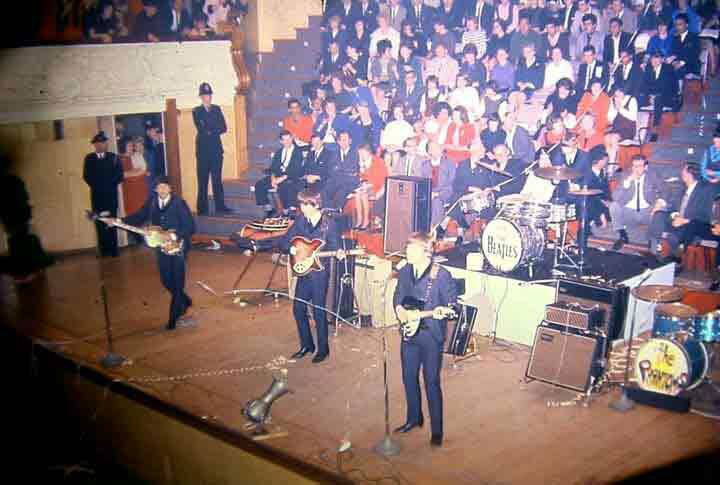
The Beatles in Auckland Town Hall, 1964. - Richard Morris collection
The Beatles were followed by a package show by the Rolling Stones and Roy Orbison in 1965 (supported by Ray Columbus and the Invaders), The Beach Boys that same year, and The Who in 1968. The crowd was kept in check in those cases – the next local heart-throb to be mobbed onstage there was Mr Lee Grant in 1967.
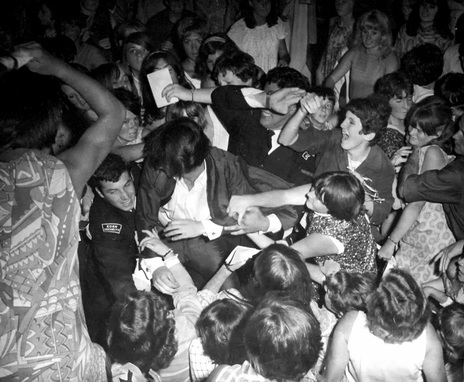
Mr. Lee Grant grapples with hysterical teen mania at Auckland Town Hall, 1967.
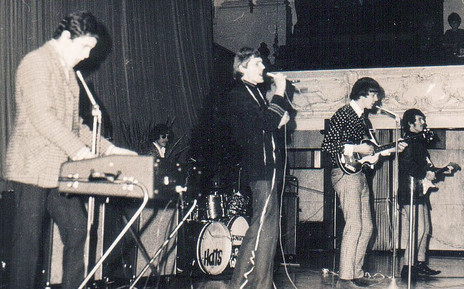
The Hi-Revving Tongues at the 1967 Battle Of The Bands, Auckland Town Hall: Bruce Coleman, Rob Noad, Chris Parfitt, John Walmsley and Mike Balcombe
Not that all the music at the Town Hall had changed with the times. The Auckland Lyric Harmonists Choir (or Auckland Lyric Choir) was formed in 1938 and performed regularly in the Concert Chamber (including yearly Christmas carol recitals) until their founder, Mr Claude Arthur Laurie, brought the group to an end by retiring as its conductor in 1969.

Dick Frizzell-designed poster for the 1975 Dragon and Space Waltz show.

Waves in concert, Auckland Town Hall, 1975. From left: Michael Matthew, David Marshall, Graeme Gash, Kevin Wildman. – Photo by Bruce Jarvis, Auckland Libraries Heritage Collections 1704-1043A-02A

Tim Finn and Noel Crombie, Split Enz, Auckland Town Hall, 1975 - Photo by Bruce Jarvis, Auckland Libraries Heritage Collections 1704-1043A-18A
Up until the late-1970s, concerts were still usually seated affairs with some audience members placed on tiers at the back of the stage.

Count Basie (seated at piano) and band performing at Auckland Town Hall, 1979. Photo by Timothy Barnett, Auckland Libraries Heritage Collections 1709-05-05
The line-up of acts to perform around this time provides a who’s who of the most important figures in music worldwide: Lou Reed (1974), Bo Diddley (1974), Roxy Music (1975), Tina Turner (1977), Dolly Parton (1979), and Talking Heads (1979).

Talking Heads onstage at Auckland Town Hall, 1979 - Photo by Bruce Jarvis, Auckland Libraries Heritage Collections 1704-2007-11A

Geoff and Mike Chunn as Citizen Band play to a packed Auckland Town Hall, September 1978. - Photo by Murray Cammick
As time went on, audiences were no longer satisfied to simply stay in their seats. Things reached a head in late 1979 when Citizen Band booked a headlining show. They were the hot Auckland band of the moment, despite not having any singles in the charts, and their gambit paid off with a packed house dancing like crazy. The NZ Herald reported the next day that the mayor was furious:
“The floor of the 70-year-old Auckland Town Hall could have collapsed last night under the strain of 2,000 stamping, rock concert fans. Sir Dove-Myer Robinson said that the organisers had been warned that dancing in the aisles would not be allowed because of fire regulations.”
The management decided to clamp down at a subsequent show by Cheap Trick and Rip It Up contributor Louise Chunn described what unfolded: “Cheap Trick played three shows in Auckland ... Signs at all the entrances warned that the show would be stopped if any members of the audience left his or her seat during the performance. There to enforce the ruling were a battery of security men posted in front of the stage and down all the aisles. On the second night the audience were kept down until the encores. On the third night they were on their feet almost the entire evening. The hall’s management turned up the house lights as soon as the set had finished; 10 minutes of clapping and calling for an encore followed.” (Rip It Up, November 1979)

Sandal-wearing blues fans join a hot-pants wearing John Mayall on stage at Auckland Town Hall, 1972. Photos by Bruce Jarvis, Auckland Libraries Heritage Collections 1704-0826A-10, 1704-0826C-08A

Frank Zappa performing at Auckland Town Hall, 1976. Photo by Bruce Jarvis, Auckland Libraries Heritage Collections 1704-1112C-06

Joan Armatrading performing at Auckland Town Hall. Photo by Bruce Jarvis, Auckland Libraries Heritage Collections 1704-1672C-42

The Temptations performing at Auckland Town Hall, 1975. Photo by Bruce Jarvis, Auckland Libraries Heritage Collections 1704-1076D-03
The rules were relaxed from this point onward and Auckland Town Hall was able to continue as one of the city’s most active venues, with shows by Split Enz (1980), Gary Numan (1980), The Cure (1981), Bjork’s band The Sugarcubes (1990), Faith No More (1990), Motörhead (1991), Jane’s Addiction (1991), The Fall (1991), De La Soul (1991), and Public Enemy with Ice-T (1992). By the 1990s, it was sometimes hard for music fans to decide which show to attend. Fans of heavy music were particularly stricken in 1995 when a single week saw the Great Hall host Ice T’s Body Count, Suicidal Tendencies, and Slayer.

Auckland Town Hall and Aotea Square during the 1984 Thank God It's Over concert featuring DD Smash, Herbs, Mockers. - Bruce Jarvis, Auckland Libraries Heritage Collections 1704-3290-05
The building was beginning to show its age. When Sonic Youth played in 1993, fans reported that the paint fell from the ceiling during the first few songs. The following year, the hall was closed for two years while work began on a project to refurbish the building at a cost of $32.8 million.
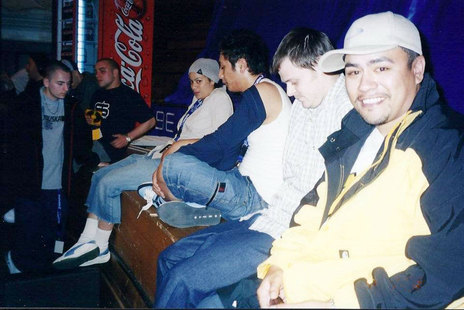
Auckland Hip-Hop Summit, Auckland Town Hall, 2002 - P-Money, DJ Shan, Ladi-6, Scribe, Callum August, Koma - Brett 'Omega B' Wagner Collection
In the early 2000s, The Auckland Town Hall was host to the Aotearoa Hip Hop Summit which helped usher in the golden years of local rap. The yearly, multi-day event took over not only the Great Hall, but also Aotea Square and included performances by many of the greats of the era, including Nesian Mystik, Che Fu, Deceptikonz, Scribe, and King Kapisi.
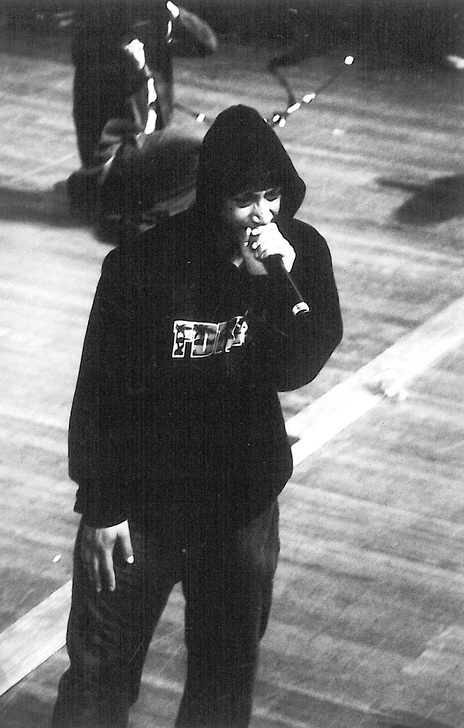
Scribe onstage at Auckland's 2002 Hip-Hop Summit, Auckland Town Hall - Photo by Gareth Shute
Sir-Vere recalls. “Scribe was playing and it was absolute mayhem. It was like The Beatles. The roar was incredible. I was sitting in the balcony watching with the headliner DJ Jazzy Jeff, who is a Grammy-award winner and has toured the world with Will Smith. he leant over to me and said ‘Why did you put me on after that guy?’”
The Hip Hop Summit wasn’t without its problems. One year, the then-manager of Mai FM decided to pull their sponsorship of the summit at the last minute, leaving the organisers tens of thousands of dollars in the red. Fortunately the council and other sponsors came together at the last moment to save the day.
Marilyn Manson’s show in 2009 had trouble of a different kind, when someone set off a fire alarm two songs into the set. The crowd had to leave and re-enter before the show could go on.
The amazing thing about the Auckland Town Hall is that while its stage has seen all manner of music over the past century, it continues to also have some performances that wouldn’t have been out of place when it opened. It is still the main venue for both the Auckland Philharmonia Orchestra and the New Zealand Symphony Orchestra. These orchestras have endeavoured to reach modern audiences by having special performances backing the best of local pop and rock acts, as when the NZSO played with The Phoenix Foundation in 2018 or when the APO played with Leisure in 2019.
The Concert Chamber has similarly bridged old and new styles of music. It is a regular venue for the NZ Trio, but was also used as part of the Flying Nun 40th anniversary celebration which saw Mermaidens, Wax Chattels, The Subliminals, and Superette perform on its stage. In 1993 The Concert Chamber provided a set for Kerry Brown’s surreal video for Dave Dobbyn’s ‘Maybe the Rain’.
Twice a year there are also free concerts on the massive pipe organ which is plumbed into the back of the stage. Occasionally it’s also been used in other ways too. Lawrence Arabia incorporated it into one of his songs at a show in 2012 and, the year before, Taylor Hawkins from the Foo Fighters convinced someone from the venue to let him play on it at soundcheck (he jammed out a very rough version of ‘Lucky’ by Radiohead with their guitar tech playing along on drums) and he played a few bars at the start of their set. The Foo Fighters were performing a charity concert there in response to the 2011 Christchurch earthquake and it was one of the only recent times when the audience was once again allowed to sit behind the band.

The stage and pipe organ in the new Auckland Town Hall, 1911 - Ernest De Tourret, Auckland Libraries Heritage Collections 1293-06
From front of house, the pipe organ looks the same as when it was first unveiled. It is misleading, since the pipes that tower above the rear of the stage are actually just for show. The actual organ workings have actually been replaced multiple times over the years, with the current $4 million organ installed in 2009-10.

Neil Finn at Auckland Town Hall, 2015, with drummer Chris O'Connor in background. - Andre Upston Collection

Diggy Dupé performing at Elemental Nights, Auckland Town Hall concert chamber, 28 July 2022.
The Auckland Town Hall remains as central to the local live scene as ever. Its role has gone beyond just the headlining shows, since it has also hosted Telethons, the APRA Silver Scroll Award, Smokefreerockquest, and the student radio awards. No doubt it will contribute to the music industry in new, unforeseen ways in its second century as a live institution.
--